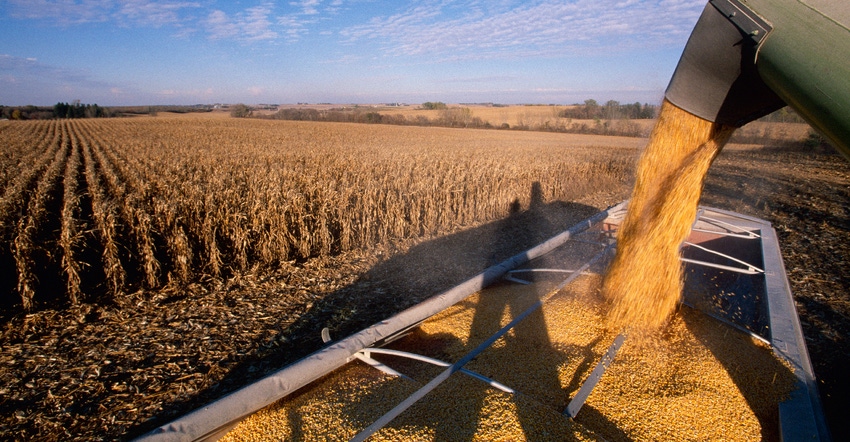
Michigan corn growers are looking at quality yields for the 2020 crop year, and favorable weather conditions allowed for a relatively smooth and early harvest.
However, yields have tumbled slightly from stellar predictions set in August, after several weeks of dry weather.
The Corn Marketing Program of Michigan's fifth annual Between the Rows Crop Tour estimated the largest corn yield in the last five years — upward of 180 bushels per acre — after conducting 300 field checks in August.
“Early on, it was predicted to be one of the best years in regard to yield per acre, but lack of rain in parts of Michigan took that high-end yield off, and we had large pockets that ended up being below average,” says Jim Zook, executive director of the CMPM.
“But from Lansing to the Thumb area, we did see above-average yields. Overall, for the state, we believe we’ll be toward the top of our productivity, but we won’t know until sometime in January. I believe yield will be somewhere in the 160s [state average bushels per acre]. We could be at the top end.”
According to the USDA November crop forecast, Michigan is expected to have an average yield of 160 bushels, up 13 bushels from last year.
Matt Frostic, president of the Michigan Corn Growers Association and CMPM, fared a little better than the forecast on his farm in Sanilac County near Sandusky. He’s farming about 1,000 acres, but also works with Ken Landsburg and his 2,500 acres.
“So, I have a shared experience,” Frostic says. “Corn harvest was uneventful with perfect weather. We started out with 24% moisture and finished down to 18%.”
Yields on this Thumb-area farm were between 175 and 240 bushels per acre, with an estimated average between 200 and 210. “That’s above average for us, and the test weight was phenomenal — as good as soybeans depending on rainfall in key times,” he says. “The crop was easy to get in the bin and in good condition. We don’t always get quality and quantity in the same sentence, but this year we did.”
Great planting conditions provided optimism for Michigan’s soybean growers and, unlike 2019, many fields went in early.
“However, some areas contended with heavy, early rains and faced some replant, while other areas missed out on those critical August rains and suffered through harvest,” explains Janna Fritz, executive director of the Michigan Soybean Promotion Committee. “The statewide average will likely shake out to be around the 48- to 49-per-bushel range — improved over last year, but about average overall.”
Michigan’s soybean yield is forecast at 48 bushels per acre, up 7.5 bushels from a year ago, and production is expected to be 105 million bushels, up 51% from 2019’s weather devastated crop.
Frostic’s soybeans were light on white mold, and yields ranged between 50 and 70 bushels. On his farm, soybean harvest finished Oct. 20, while corn was wrapped up Nov. 18.
Ohio's harvest
Ohio is expected to harvest 554 million bushels of corn, with an average yield of 168 bushels per acre — up 4 bushels from last year.
“I think they’re [USDA] hallucinating on the projected corn yield,” says Jan Layman, president of Ohio No-till Council, who farms about 3,200 acres of corn and 2,500 acres of beans in Kenton, 30 miles south of Finley.
“But it really depends on what rain cloud you are under,” he adds. “Here, we had a cold and dry April, cold and wet May, hot and dry June and July, and then double the average rainfall in September and October.
“Corn never got enough moisture to get ahold of the nitrogen early on, and then we got a bunch of rain in late August [and] early September, and October. We’re dealing with ear mold and high vomitoxin, resulting in poor corn yields and poor quality.”
With about a third of the crop yet to be harvested in early December, his yields have been between 100 and 150 bushels per acres. “Luckily, we have some corn sold into a chicken farm. Poultry are more tolerant to the vomitoxin than hogs, which simply won’t eat it if it’s too high.”
However, the bright spot of harvest was soybeans. “They’re as good as we’ve ever had. I wish we would have planted it all to beans,” he says. “Surprisingly, those late rains made a difference on beans.”
He says yields ranged from the high 40 bushels per acre up to 79, with an average of 59.
USDA is forecasting Ohio soybean growers to yield an average of 54 bushels per acre, up 5 bushels from last year, with total production at 264 million bushels, up 26% from last year.
About the Author(s)
You May Also Like






